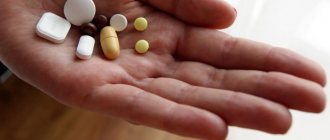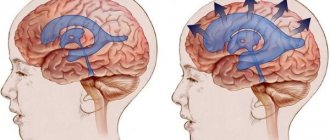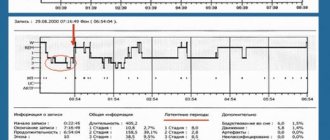pharmachologic effect
A derivative of diphenylmethane, it has moderate anxiolytic activity;
It also has a sedative, antiemetic, antihistamine and m-anticholinergic effect. Blocks central m-cholinergic receptors and histamine H1 receptors and inhibits the activity of certain subcortical zones. Does not cause mental dependence or addiction. The clinical effect occurs 15-30 minutes after taking the drug orally. Has a positive effect on cognitive abilities, improves memory and attention. Relaxes skeletal and smooth muscles, has bronchodilator and analgesic effects, and a moderate inhibitory effect on gastric secretion. Hydroxyzine significantly reduces itching in patients with urticaria, eczema and dermatitis. With long-term use, there was no withdrawal syndrome or deterioration of cognitive functions. Polysomnography in patients with insomnia and anxiety clearly demonstrates an increase in sleep duration and a decrease in the frequency of night awakenings after a single or repeated dose of hydroxyzine at a dose of 50 mg. A decrease in muscle tension in patients with anxiety was noted when taking the drug at a dose of 50 mg 3 times a day.
Composition of the medicine
The main active component - hydroxyzine - has a calming, anti-allergenic, analgesic, antispasmodic effect, and also increases concentration, improves attention and cognitive functions. If anxiety is pronounced, and chronic insomnia is also associated with it, then Atarax, or rather hydroxyzine, relieves anxiety, normalizes sleep, strengthening and increasing its duration, and reduces the frequency of awakenings at night. The drug is able to relax skeletal muscles, as well as smooth muscles. All this is due to the effect of the drug Atarax on certain areas of the subcortical zones of the brain.
The drug is absorbed into the gastrointestinal tract, after which it quickly enters the systemic circulation. That is why the effect of taking Atarax is noticeable within 15-30 minutes.
If you take Atarax for a long time, then addiction or dependence on the drug will not develop. This means that he does not have “withdrawal syndrome”.
Pharmacokinetics
Suction
Hydroxyzine is highly absorbed from the gastrointestinal tract. Cmax is observed 2 hours after taking the drug.
After a single dose of the drug in a single dose of 25 mg or 50 mg in adults, the plasma concentration is 30 ng/ml and 70 ng/ml, respectively.
Bioavailability when taken orally and intramuscularly is 80%.
Distribution
Hydroxyzine is more concentrated in tissues (particularly skin) than in plasma. The distribution coefficient is 7-16 l/kg.
Hydroxyzine penetrates the BBB and the placental barrier, concentrating more in the fetal tissues than in the mother's body. Metabolites are found in breast milk.
Metabolism and excretion
Hydroxyzine is metabolized in the liver. The main metabolite (45%) is cetirizine, which is a histamine H1 receptor blocker. The total clearance of hydroxyzine is 13 ml/min/kg. T1/2 in adults is 14 hours. Only 0.8% of hydroxyzine is excreted unchanged in the urine.
Pharmacokinetics in special clinical situations
In children, the total clearance is 4 times less than in adults, T1/2 in children aged 14 years is 11 hours, in children aged 1 year - 4 hours.
In elderly patients, T1/2 is 29 hours, the distribution coefficient is 22.5 l/kg.
In patients with impaired liver function, T1/2 increases to 37 hours, the concentration of metabolites in the blood serum is higher than in young patients with normal liver function. The antihistamine effect can last for 96 hours.
Indications
- adults: for the relief of anxiety, psychomotor agitation, feelings of internal tension, increased irritability in neurological, mental (including generalized anxiety, adaptation disorders) and somatic diseases, chronic alcoholism; withdrawal syndrome in chronic alcoholism, accompanied by psychomotor agitation;
- as a sedative during premedication;
- skin itching (as symptomatic therapy).
Atarax for neuroses and panic attacks
Neuroses are a fairly common diagnosis. This is a reversible neuropsychic disorder, which is provoked by constant stress, chronic fatigue, tension and anxiety. Neuroses are often accompanied by panic attacks. A panic attack is a state of sudden and extremely intense attack of fear or anxiety. Refers to neurotic diseases.
For such conditions, the doctor may prescribe Atarax. The main purpose of this tranquilizer is to calm and relieve anxiety. The product must be used strictly as prescribed by the doctor in the prescribed dosage and regularity. Atarax suppresses the activity of certain areas of the brain, relieving tension and panic attacks.
Contraindications
- porphyria;
- pregnancy;
- period of labor;
- lactation period (breastfeeding);
- hypersensitivity to the components of the drug;
- hypersensitivity to cetirizine and other piperazine derivatives, aminophylline or ethylenediamine.
It is not recommended to prescribe Atarax tablets to patients with hereditary galactose intolerance, as well as impaired absorption of glucose and galactose, because The tablets contain lactose.
The drug should be prescribed with caution for myasthenia gravis, prostatic hyperplasia with clinical manifestations, difficulty urinating, constipation, increased intraocular pressure, dementia, and a tendency to seizures; with a predisposition to the development of arrhythmia; with simultaneous use of drugs that have arrhythmogenic effects; simultaneously with other CNS depressants or anticholinergics (dose reduction required). A reduction in the dose of the drug is required in patients with severe and moderate renal failure, with liver failure, and in elderly patients with decreased glomerular filtration.
Hydroxyzine 25 mg, 25 film-coated tablets (Pharmproekt)
Registration Certificate Holder
PHARMPROJECT (Russia)
Dosage form
Medicine - Hydroxyzine
Description
Film-coated tablets
white, round, biconvex; On a cross section, the core is white to almost white.
1 tab.
hydroxyzine hydrochloride 25 mg
Excipients
: lactose monohydrate - 54.2 mg, microcrystalline cellulose (type 102) - 48.85 mg, colloidal silicon dioxide - 1.3 mg, magnesium stearate - 0.65 mg.
Film shell composition:
opadry white (20A280013) - 4 mg [hypromellose (hydroxypropyl methylcellulose) - 33.75%, hydroxypropylcellulose - 33.75%, talc - 20%, titanium dioxide - 12.5%].
10 pieces. — contour cell packaging (2) — cardboard packs. 10 pieces. — cellular contour packages (3) — cardboard packs. 10 pieces. — contour cell packaging (5) — cardboard packs. 25 pcs. — bottles (1) — cardboard packs.
Indications
Neuroses and neurotic conditions, manifested by increased excitability, feelings of emotional stress, anxiety; organic lesions of the central nervous system, accompanied by increased excitability; withdrawal syndrome in chronic alcoholism; premedication before surgical operations, prevention and relief of vomiting in the postoperative period; skin itching.
Contraindications for use
Porphyria, benign prostatic hyperplasia, angle-closure glaucoma, congenital or acquired prolongation of the QT interval on the ECG (including in history), risk factors for the development of prolongation of the QT interval on the ECG (including in the presence of cardiovascular diseases), severe electrolyte imbalance (hypokalemia, hypomagnesemia), cases of sudden cardiac death in a family history, severe bradycardia, concomitant use of drugs that can cause prolongation of the QT interval on the ECG and/or cause ventricular arrhythmias, pregnancy, childbirth, breastfeeding, hypersensitivity to hydroxyzine.
pharmachologic effect
Anxiolytic and sedative, histamine H1 receptor blocker, piperazine derivative. Has moderate m-anticholinergic activity. Has an antiemetic effect.
Drug interactions
When used simultaneously, hydroxyzine enhances the effects of analgesics, anxiolytics, barbiturates, and ethanol.
Dosage regimen
For oral administration, a single dose for adults varies from 25 mg to 100 mg; the frequency of administration, depending on the indications, is 1-4 times/day.
To quickly achieve a therapeutic effect, a hydroxyzine solution is administered deeply intramuscularly at a dose of 50-100 mg; then it can be administered at intervals of 4-6 hours.
Side effect
From the central nervous system and peripheral nervous system:
drowsiness, increased fatigue, tremor, convulsions, headache, dizziness, ataxia, weakness.
From the side of the organ of vision:
acute glaucoma, accommodation disorder.
From the urinary system:
acute urinary retention.
From the cardiovascular system:
tachycardia, decreased blood pressure.
From the digestive system:
dry mouth, constipation, increased transaminase activity.
Other:
bronchospasm, allergic reactions, increased sweating.
special instructions
Use with caution in patients with renal failure, myasthenia gravis, difficulty urinating, constipation, dementia, a tendency to seizures, arrhythmias or taking antiarrhythmic drugs, with impaired liver and/or kidney function.
With subcutaneous administration of hydroxyzine, tissue damage is possible; with intravenous administration, hemolysis is possible.
If allergy tests are necessary, hydroxyzine should be discontinued 5 days before the test.
Impact on the ability to drive vehicles and machinery
During the period of therapy, it is necessary to refrain from engaging in potentially hazardous activities that require increased attention and rapid psychomotor reactions.
Use during pregnancy and breastfeeding
Restrictions during pregnancy - Contraindicated. Restrictions when breastfeeding - Contraindicated.
Hydroxyzine is contraindicated for use during pregnancy, childbirth, and breastfeeding.
Use for renal impairment
Restrictions for impaired renal function - With caution.
Use with caution in patients with renal failure; dose reduction required.
Use for liver dysfunction
Restrictions for liver dysfunction - With caution.
Use with caution in patients with liver failure; dose reduction required.
Use in elderly patients
Restrictions for elderly patients - With caution. In elderly patients, the maximum daily dose is 50 mg.
Use in children
Restrictions for children - With caution.
Contraindicated for use in children under 3 years of age.
Dosage
The drug is taken orally.
For the symptomatic treatment of itching in children aged 12 months to 6 years, the drug is prescribed in a daily dose of 1-2.5 mg/kg body weight in several doses; children over 6 years of age - at a dose of 1-2 mg/kg/day in several doses.
For premedication in children, the drug is prescribed at a dose of 1 mg/kg body weight 1 hour before surgery, and additionally the night before surgery.
For the symptomatic treatment of anxiety, adults are prescribed a dose of 25-100 mg/day in several doses during the day or at night. The average dose is 50 mg/day (12.5 mg in the morning, 12.5 mg in the afternoon and 25 mg at night). If necessary, the dose can be increased to 300 mg/day.
For the symptomatic treatment of itching, the initial dose is 25 mg; if necessary, the dose can be increased 4 times (25 mg 4 times a day).
The maximum single dose should not exceed 200 mg, the maximum daily dose is no more than 300 mg.
In elderly patients, the initial dose should be reduced by 2 times.
Patients with moderate to severe renal insufficiency, as well as hepatic insufficiency, require a dose reduction.
Analogs of the drug Atarax
In the pharmacy you can find the following analogues of the drug: Hydroxyzine, Phenazepam, Grandaxin, Anvifen.
Analogs of the drug Atarax
Remember that the prescription of an analogue or replacement of one drug with another is made exclusively by the attending physician, who can correlate the nature of the disease, the desired effect of taking the drug, contraindications, adverse reactions and dosage.
Atarax is sometimes compared to Phenibut. But this is not entirely true.
Atarax or Phenibut?
Phenibut is a nootropic drug that improves cognitive abilities and has a mild tranquilizing effect. This drug effectively relieves anxiety, psycho-emotional stress, and improves sleep. But Atarax is a tranquilizer, most often used to relieve itching, reduce anxiety and psychomotor agitation.
Side effects
Side effects associated with anticholinergic effects: rarely (mainly in elderly patients) - dry mouth, urinary retention, constipation, impaired accommodation.
From the central nervous system: drowsiness, general weakness (especially at the beginning of treatment), headache, dizziness. If weakness and drowsiness do not disappear after a few days from the start of therapy, the dose of the drug must be reduced. Very rarely (with significant overdose) - tremors, convulsions, disorientation.
From the cardiovascular system: arterial hypotension, tachycardia.
From the digestive system: nausea, changes in liver function tests.
Other: increased sweating, allergic reactions, fever, bronchospasm.
When using the drug in recommended doses, no clinically significant respiratory depression was observed. Involuntary motor activity (including very rare cases of tremors and convulsions), disorientation were observed with significant overdose.
Side effects observed when taking Atarax are usually mild, transient and disappear within a few days of starting treatment or after reducing the dose.
Atarax and alcohol
Drinking alcohol is prohibited while taking Atarax medication
During therapy with the drug, drinking alcohol is prohibited, as alcohol enhances the effect of the drug and provokes adverse reactions. That is, the central nervous system is depressed, the state of intoxication increases, blood pressure decreases, and allergic reactions appear. With all this, there is a high risk of severe intoxication of the body, which can lead to death.
Overdose
Symptoms: increased anticholinergic effects, depression or paradoxical stimulation of the central nervous system, nausea, vomiting, involuntary motor activity, hallucinations, impaired consciousness, arrhythmia, arterial hypotension; rarely - tremors, convulsions, disorientation, which occur with a significant overdose.
Treatment: if spontaneous vomiting is absent, it is necessary to induce it artificially or perform gastric lavage. Carry out general measures aimed at maintaining the vital functions of the body, and monitor the patient until the symptoms of intoxication disappear in the next 24 hours.
If it is necessary to obtain a vasopressor effect, norepinephrine or metaramenol is prescribed. Epinephrine should not be used. There is no specific antidote. The use of hemodialysis is ineffective.
Drug interactions
Atarax potentiates the effect of drugs that depress the central nervous system, such as opioid analgesics, barbiturates, tranquilizers, hypnotics, ethanol (combinations require individual selection of drug doses).
Atarax, when used simultaneously, interferes with the pressor effect of epinephrine (adrenaline) and the anticonvulsant activity of phenytoin, and also interferes with the action of betahistine and cholinesterase blockers.
With simultaneous use, Atarax does not affect the activity of atropine, belladonna alkaloids, cardiac glycosides, antihypertensive drugs, histamine H2 receptor blockers.
Co-administration of Atarax with MAO inhibitors and anticholinergics should be avoided.
Hydroxyzine is an inhibitor of the CYP2D6 isoenzyme and, when used in high doses, may cause interactions with CYP2D6 substrates. Since hydroxyzine is metabolized in the liver, an increase in its concentration in the blood can be expected when co-administered with liver enzyme inhibitors.
Compatibility with other drugs
A separate issue when taking Atarax is its interaction with other medications. Thus, barbiturates, tranquilizers, opioid analgesics, ethanol-containing drugs, sleeping pills and any other drugs that depress the central nervous system, when taken simultaneously with the drug Atarax, enhance the effects. That is, lethargy, indifference, drowsiness and other effects will appear several times brighter and stronger. But if it is still necessary to take everything together, then the doctor monitoring the patient will draw up a dosage regimen and select an individual dosage for each drug.
Compatibility of other drugs with Atarax
The combination of Atarax + MAO inhibitors, anticholinergics is not recommended. Atarax is able to inhibit the action of epinephrine (adrenaline) and suspend the anticonvulsant effect of phenytoin.
Atarax has a destructive effect on the metabolism of substrate drugs for uridine diphosphate and glucuronyl transferase.
If you drink Cimetidine and Atarax at the same time, the concentration of hydroxyzine in the blood plasma will increase, but on the contrary, the concentration of metabolites will decrease.
As for cardiac glycosides, atropines, antihypertensive drugs, antiallergic drugs, Atarax does not in any way affect their functionality; the pharmacological effect provided.
However, it is worth remembering that it is better not to take drugs whose side effects indicate possible arrhythmia with Atarax. When they are mixed, there is a risk of prolongation of the QT interval and the development of ventricular tachycardia of the “pirouette” type.
special instructions
If allergy tests are necessary, Atarax should be discontinued 5 days before the test.
Patients taking Atarax should avoid drinking alcohol.
Impact on the ability to drive vehicles and operate machinery
Patients taking Atarax, if necessary to drive a car or operate machinery, should be warned that the drug may affect concentration and the speed of psychomotor reactions.



